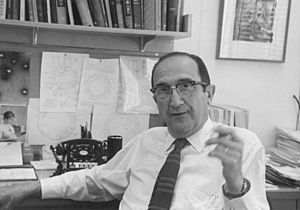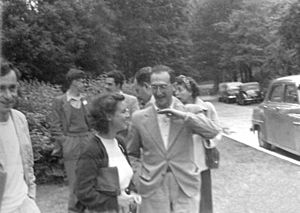Salvador Luria facts for kids
Quick facts for kids
Salvador Luria
|
|
|---|---|

Luria c. 1969
|
|
| Born |
Salvatore Luria
August 13, 1912 |
| Died | February 6, 1991 (aged 78) Lexington, Massachusetts, U.S.
|
| Nationality | Italian (1912–1991) American (1950–1991) |
| Alma mater | Università degli Studi di Torino |
| Spouse(s) | Zella Hurwitz (m. 1945; 1 child) (1924-2018) |
| Awards | The John Simon Guggenheim Memorial Fellowship (1942) Nobel Prize in Physiology or Medicine (1969) Louisa Gross Horwitz Prize (1969) |
| Scientific career | |
| Fields | Molecular biology |
| Institutions | Columbia University Indiana University University of Illinois at Urbana–Champaign Massachusetts Institute of Technology |
| Doctoral students | James D. Watson Jon Kabat-Zinn |
Salvador Edward Luria (born August 13, 1912 – died February 6, 1991) was a brilliant scientist from Italy who later became a citizen of the United States. He was a microbiologist, which means he studied tiny living things like bacteria and viruses. In 1969, he won the famous Nobel Prize in Physiology or Medicine along with two other scientists, Max Delbrück and Alfred Hershey. They earned this award for their amazing discoveries about how viruses make copies of themselves and how their genetic information is put together. Salvador Luria also found out that bacteria can become resistant to viruses (called phages) and that this ability is passed down through their genes.
Contents
Salvador Luria's Life and Discoveries
Early Years and Education
Salvador Luria was born Salvatore Luria in Turin, Italy. His family was a well-known Italian Sephardi Jewish family. His parents were Davide and Ester Luria. He went to medical school at the University of Turin. There, he met two other future Nobel winners: Rita Levi-Montalcini and Renato Dulbecco. He finished his studies in 1935.
From 1936 to 1937, Luria served in the Italian army as a medical officer. After that, he took classes in radiology (using X-rays) at the University of Rome. This is where he learned about Max Delbrück's ideas that genes are like molecules. Luria then started thinking about ways to test these ideas using bacteriophages, which are viruses that infect bacteria.
In 1938, he was given a special scholarship to study in the United States. He hoped to work with Delbrück there. However, soon after he received the award, the fascist government in Italy made a rule that Jewish people could not get academic research scholarships. Because he couldn't get money for his work in the U.S. or Italy, Luria left Italy for Paris, France, in 1938. When the Nazi German armies invaded France in 1940, Luria quickly rode his bicycle to Marseille. There, he got a visa to move to the United States.
Amazing Discoveries with Phages

Luria arrived in New York City on September 12, 1940. He soon changed his first and middle names to Salvador Edward. A physicist he knew from Rome, Enrico Fermi, helped him get a scholarship at Columbia University. He quickly met Delbrück and Hershey. They worked together on experiments at Cold Spring Harbor Laboratory and in Delbrück's lab.
In 1943, Luria and Delbrück did a very famous experiment, now called the Luria–Delbrück experiment. They showed that bacteria develop resistance to viruses in a way similar to how Darwin's idea of natural selection works. This means that random changes (mutations) in bacteria can make them resistant to viruses, even if the virus isn't around. This idea was very important because it helped explain how bacteria can become resistant to antibiotics.
From 1943 to 1950, Luria worked at Indiana University. One of his first students was James D. Watson, who later helped discover the structure of DNA. In January 1947, Luria became a U.S. citizen.
In 1950, Luria moved to the University of Illinois. In the early 1950s, Luria and Giuseppe Bertani found something new about how bacteria protect themselves from viruses. They saw that a type of bacteria called E. coli could stop viruses from growing if the viruses came from a different type of bacteria. Later, other scientists found out that bacteria make special enzymes called restriction enzymes. These enzymes cut the DNA of viruses but don't harm the bacteria's own DNA. These restriction enzymes became incredibly important tools in molecular biology, helping scientists study and change DNA.
In 1969, Salvador Luria, Max Delbrück, and Alfred Hershey won the Nobel Prize in Physiology or Medicine. They were honored for their discoveries about how viruses copy themselves and how their genetic material is organized.
Later Research and Leadership
In 1959, Luria became the head of the Microbiology department at the Massachusetts Institute of Technology (MIT). At MIT, he changed his research focus from phages to cell membranes (the outer layers of cells) and bacteriocins (proteins made by bacteria that can harm other bacteria).
In 1963, while studying in Paris, he found that bacteriocins damage cell membranes. Back at MIT, his lab discovered that bacteriocins do this by making tiny holes in the cell membrane. These holes allow important charged particles, called ions, to leak out, which destroys the cell's energy system. In 1972, he became the head of The Center for Cancer Research at MIT. The department he created included future Nobel Prize winners like David Baltimore and Phillip Allen Sharp.
Besides the Nobel Prize, Luria received many other awards. He was chosen to be a member of the American Academy of Arts and Sciences in 1959 and the National Academy of Sciences in 1960. He also served as president of the American Society for Microbiology from 1968 to 1969. In 1974, he won the National Book Award for his science book Life: the Unfinished Experiment. He also received the National Medal of Science in 1991.
Speaking Out for Change
Throughout his life, Luria was known for speaking up about important social and political issues. In 1957, he joined with scientist Linus Pauling to protest against testing nuclear weapons. Luria was also against the Vietnam War and supported workers' rights.
In the 1970s, he was involved in discussions about genetic engineering, which is about changing the genes of living things. He believed there should be some rules and oversight for this new science, rather than a complete ban or no rules at all. Because of his strong political views, he was briefly prevented from receiving money for his research from the National Institutes of Health in 1969.
Final Years
Salvador Luria passed away in Lexington, Massachusetts, from a heart attack on February 6, 1991. He was 78 years old.
See also
 In Spanish: Salvador Edward Luria para niños
In Spanish: Salvador Edward Luria para niños
- List of Jewish Nobel laureates
- Phage group
- Luria–Delbrück experiment

